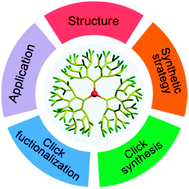Hyperbranched polymers: advances from synthesis to applications
Abstract
Hyperbranched polymers (HPs) are highly branched three-dimensional (3D) macromolecules. Their globular and dendritic architectures endow them with unique structures and properties such as abundant functional groups, intramolecular cavities, low viscosity, and high solubility. HPs can be facilely synthesized via a one-pot polymerization of traditional small molecular monomers or emerging macromonomers. The great development in synthetic strategies, from click polymerization (i.e., copper-catalyzed azide–alkyne cycloaddition, metal-free azide–alkyne cycloaddition, strain-promoted azide–alkyne cycloaddition, thiol–ene/yne addition, Diels–Alder cycloaddition, Menschutkin reaction, and aza-Michael addition) to recently reported multicomponent reactions, gives rise to diverse HPs with desirable functional/hetero-functional groups and topologies such as segmented or sequential ones. Benefiting from tailorable structures and correspondingly special properties, the achieved HPs have been widely applied in various fields such as light-emitting materials, nanoscience and technology, supramolecular chemistry, biomaterials, hybrid materials and composites, coatings, adhesives, and modifiers. In this review, we mainly focus on the progress in the structural control, synthesis, functionalization, and potential applications of both conventional and segmented HPs reported over the last decade.

- This article is part of the themed collection: Dendrimers and Hyperbranched Polymers

 Please wait while we load your content...
Please wait while we load your content...